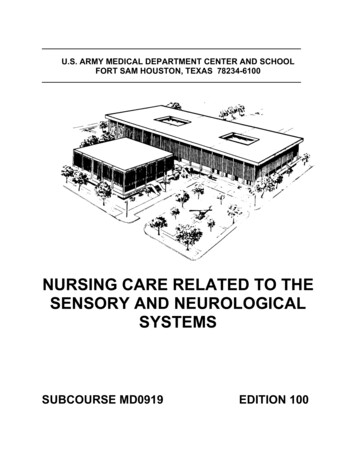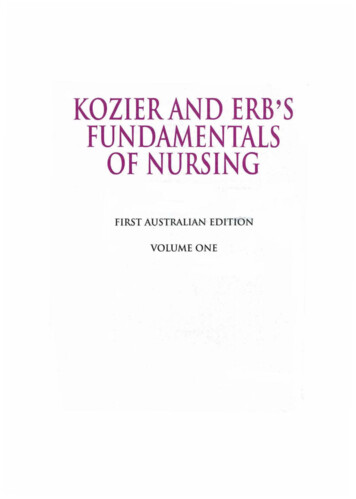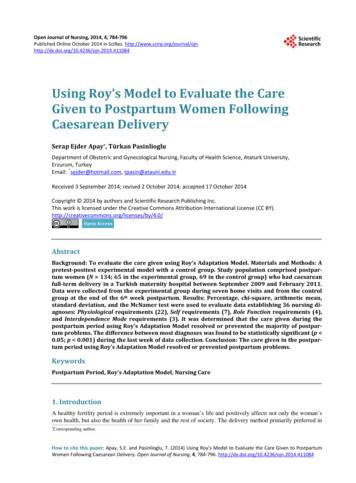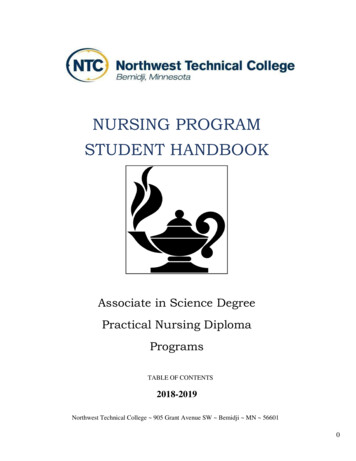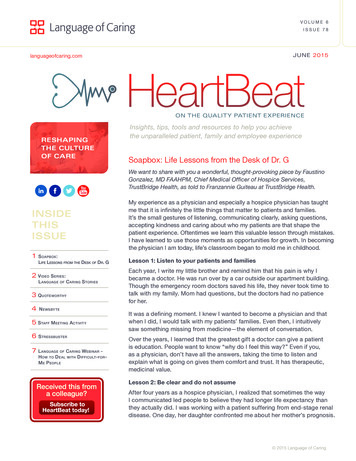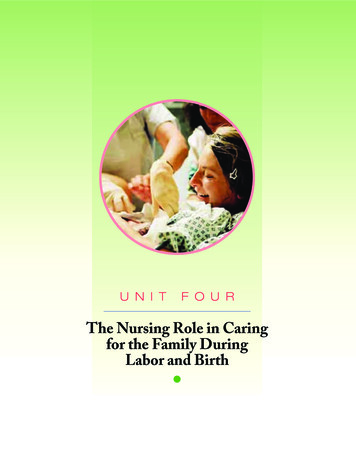
Transcription
U N I TF O U RThe Nursing Role in Caringfor the Family DuringLabor and Birth
C H A P T E R1 8Caring for a WomanDuring Vaginal BirthKey TermsObjectivesamnioinfusionattitudebreech presentationcardinal movements of laborcephalic episiotomyfetal descentLeopold’s maneuversliemoldingpathologic retraction ringphysiologic retraction ringpositionripeningstationtransitionAfter mastering the contents of this chapter, you should be able to:1. Describe common theoriesexplaining the onset of labor.2. Discuss the role of thecomponents of labor:passenger, passage,and powers.3. Assess a woman in labor,identifying her stage andprogression.4. Formulate nursing diagnosesrelated to the physiologic andpsychological aspects of labor.5. Establish expected outcomesto meet the needs of a womanthroughout the labor process.6. Implement nursing care for afamily during labor.7. Evaluate expected outcomesfor achievement andeffectiveness of nursing care.8. Identify National Health Goalsrelated to safe labor and birththat nurses can help the nationachieve.9. Identify areas related to laborand birth that could benefitfrom additional nursingresearch or application ofevidence-based practice.10. Use critical thinking to analyzethe effectiveness of nursingcare measures to meet theneeds of women and theirfamilies so that labor is familycentered.11. Integrate knowledge of nursingcare in labor with nursingprocess to achieve qualitymaternal and child healthnursing care.Celeste Bailey is a 26-year-old you admit to a birthing room. She’s been having contractions 45 secondslong and 3 minutes apart for the last 6 hours. She tells you she wants to have her baby “naturally” withoutany analgesia or anesthesia. Her husband is in the Army and assigned overseas, so he is not with her.Although her sister lives only two blocks from the hospital, Celeste doesn’t want her called. She asks if shecan talk to her mother on the telephone instead. As you finish assessing contractions, she screams with painand shouts, “I’m doing everything I’m supposed to do! How much longer does this go on?”Previous chapters described the anatomic and physiologic changes that occur in pregnancyas well as effective steps women can take to prepare for labor. This chapter adds informationabout the labor process and how to explain what is happening during labor to a woman andgive support. This is important information, because labor can be a frightening process ifsupport people are not present.What teaching does Celeste need about labor and birth?After you’ve studied this chapter, access the accompanying website. Read thepatient scenario and answer the questions to further sharpen your skills, growmore familiar with RN-CLEX types of questions, and reward yourself with howmuch you have learned.
488UNIT 4 The Nursing Role in Caring for the Family During Labor and BirthLabor is the series of events by which uterine contractions and abdominal pressure expel a fetus andplacenta from a woman’s body. Regular contractionscause progressive dilatation of the cervix and sufficientmuscular force to allow the baby to be pushed to the outside. It is a time of change, both an ending and a beginning, for a woman, a fetus, and her family.Labor and birth require a woman to use all the psychological and physical coping methods she has available.Regardless of the amount of childbirth preparation orthe number of times she has been through the experiencebefore, family-focused nursing care is needed to supportthe family as they mark the beginning of a new family structure. This need is further emphasized by National HealthGoals (Box 18.1).Nursing Process OverviewFor a Woman in LaborLabor and birth are enormous emotional and physiologicaccomplishments, not only for a woman but for her support person as well. For this reason, support personsshould be treated with respect and included in all phasesof the process whenever possible. Interventions thatBOX 18.1 FOCUS ON . . .NATIONAL HEALTH GOALSBecause labor and birth are high-risk times forboth the fetus and the mother, a number of NationalHealth Goals speak directly to them (DHHS, 2000): Reduce the rate of maternal deaths to no more than3.3/100,000 live births, from a baseline of7.1/100,000. Reduce the rate of fetal deaths at 20 or more weeks’gestation to no more than 4.1/1000 live births, from abaseline of 6.8/1000. Reduce the rate of fetal and infant deaths during theperinatal period (28 weeks’ gestation to 7 days afterbirth) to no more than 4.5/1,000 live births, from abaseline of 7.5/1,000 live births.Nurses can help the nation achieve these goals byclosely monitoring women during labor and birth andby teaching women as much as possible about labor,so that they are able to use as little analgesia andanesthesia as possible. The less anesthesia andanalgesia used, the fewer the complications that canresult in fetal or maternal death.Topics that could benefit from additional nursingresearch in this area are advantages and disadvantages of various birthing settings; the best way toteach unprepared women the breathing patterns forlabor; how support people can best be prepared fortheir role; and advantages and disadvantages ofvarious birthing or labor positions.make the experience more positive and memorable forthem help to contribute to future family interactions. AssessmentAssessment of a woman in labor must be done quicklyyet thoroughly and gently. A woman is keenly aware ofwords spoken around her and the manner with whichprocedures are carried out. Because of this sensitivity,she may perceive a venipuncture as a very painful experience. She may have difficulty relaxing for a vaginalexamination if she fears that pressure on the fetal headwill cause her pain. Remember that pain is a subjectivesymptom. Only the woman can evaluate how muchshe is experiencing or how much she will be able toendure.Assess how much discomfort a woman in labor ishaving, not only by what she scores on a pain scale,but also by subtle signs of pain such as facial tenseness, flushing or paleness of the face, hands clenchedin a fist, rapid breathing, or rapid pulse rate. Knowingthe extent of a woman’s discomfort helps guide thechoice of comfort interventions she may need. Nursing DiagnosisCommon nursing diagnoses used during labor includethe following: Pain related to labor contractions Anxiety related to process of labor and birth Health-seeking behaviors related to management ofdiscomfort of labor Situational low self-esteem related to inability to useprepared childbirth methodAlthough the discomfort of labor is commonly referredto as “contractions” rather than “pain,” do not omit theword “pain” from a nursing diagnosis, because theterm strengthens an understanding of the problem. Outcome Identification and PlanningWhen establishing expected outcomes for a woman inlabor and her partner, be certain they are realistic. Because labor usually takes place over a relatively shorttime frame (average, 12 hours), outcomes must bemet within this period. On the other hand, it is important not to project a definite time limit for labor to becompleted, because the length of labor can varygreatly from person to person and still be within normallimits. It is necessary also to appreciate the magnitudeof labor. It is unlikely that all the fear or anxiety experienced during a woman’s labor can be alleviated.Often, because it is such an unusual and significantexperience, an average couple may need assistancewith using additional coping measures.Be certain to incorporate both the woman and hersupport person in planning, so that the experience is ashared one. Planning may include review and education about the normal labor process. Although a couplemay have learned this information during pregnancy,the reality of labor may seem much different from whatthey imagined. Planning also must be flexible, changing with the progress of labor, and individualized,allowing a woman to experience the significanceof the event for herself.
CHAPTER 18 Caring for a Woman During Vaginal BirthComfort promotion is vital. A plan that addresses thediscomforts of labor includes planning for education,validation, and response to a woman’s pain to help hermaintain realistic perceptions about it. Be certain to include nonpharmacologic comfort measures such aschanging a wet sheet or offering a moisturizing creamfor dry lips. ImplementationInterventions in labor must always be carried out between contractions if possible, so that the woman isfree to use a prepared childbirth technique to limit thediscomfort of contractions. This calls for good coordination of care among health care providers and planning with the woman and her support person. Theperson a woman chooses to stay with her duringchildbirth can be a husband, the father of the child,a sister or parent, or a close friend. Which of thesepersons a woman chooses is somewhat culturallydetermined.It is important for women to be able to understandwhat is happening to them during labor. If the woman isnot proficient in English, make arrangements to locatean interpreter. If she is hearing challenged, it is the hospital’s responsibility to provide an interpreter for her sothat she can receive adequate explanations of herprogress. Remember that whether a woman enjoysbeing touched or not during labor is in part culturallydetermined. Assess early in a woman’s labor whethershe might benefit from such caring measures ashaving her hand held or her back rubbed. Outcome EvaluationDuring labor, evaluation must be ongoing to preservethe safety of the woman and her new child. After birth,evaluation helps to determine a woman’s opinion of herexperience with labor and birth. Ideally, the experienceshould be not only one that she was able to endure butone that allowed her self-esteem to grow and the familyto grow through a shared experience. It is advantageous to talk to women in the early postpartum periodabout their labor experience. Doing so serves as ameans of evaluating nursing care during labor. It alsoprovides a woman the chance to “work through” thisexperience and incorporate it into her self-image.Examples of possible outcome criteria include thefollowing: Client states that pain during labor was tolerablebecause of her advance preparation. Client verbalizes that her need for additional comfortmeasures was met. Client and family members state that the labor andbirth experience was a positive growth experiencefor them, both individually and as a family.THEORIES OF LABOR ONSETLabor normally begins when a fetus is sufficiently matureto cope with extrauterine life yet not too large to cause mechanical difficulty with birth. The trigger that converts therandom, painless Braxton Hicks contractions into strong,coordinated, productive labor contractions is unknown.In some instances, labor begins before a fetus is mature(preterm birth). In others, labor is delayed until the fetusand the placenta have both passed beyond the optimalpoint for birth (postterm birth).Although a number of theories have been proposed toexplain why labor begins, it is believed that labor is influenced by a combination of factors originating from themother and the fetus (Katz, 2003). These factors includethe following: Uterine muscle stretching, which results in release ofprostaglandins Pressure on the cervix, which stimulates the release ofoxytocin from the posterior pituitary Oxytocin stimulation, which works together with prostaglandins to initiate contractions Change in the ratio of estrogen to progesterone (increasing estrogen in relation to progesterone stimulates uterine contractions) Placental age, which triggers contractions at a set point Rising fetal cortisol levels, which reduce progesteroneformation and increase prostaglandin formation Fetal membrane production of prostaglandin, whichstimulates contractionsSIGNS OF LABORPreliminary Signs of LaborBefore labor, a woman often experiences subtle signs thatsignal the onset of labor. All pregnant women should betaught these signs so that they can recognize when laboris beginning.LighteningIn primiparas, lightening, or descent of the fetal presentingpart into the pelvis, occurs approximately 10 to 14 days before labor begins. This changes a woman’s abdominal contour, because the uterus becomes lower and moreanterior. Lightening gives a woman relief from the diaphragmatic pressure and shortness of breath that she hasbeen experiencing and in this way “lightens” her load.Lightening probably occurs early in primiparas becauseof tight abdominal muscles. In multiparas, it is not as dramatic and usually occurs on the day of labor or even afterlabor has begun. As the fetus sinks lower in the pelvis, themother may experience shooting leg pains from the increased pressure on the sciatic nerve, increased amountsof vaginal discharge, and urinary frequency from pressureon the bladder.Increase in Level of ActivityA woman may awaken on the morning of labor full of energy, in contrast to her feelings of chronic fatigue duringthe previous month. This increase in activity is related toan increase in epinephrine release that is initiated by a decrease in progesterone produced by the placenta. Additional epinephrine prepares a woman’s body for the workof labor ahead.489
490UNIT 4 The Nursing Role in Caring for the Family During Labor and BirthBraxton Hicks ContractionsUterine ContractionsIn the last week or days before labor begins, a womanusually notices extremely strong Braxton Hicks contractions, which she may interpret as true labor contractions.Table 18.1 summarizes the ways in which these contractions can be differentiated from true labor.Primiparas may have great difficulty in distinguishingbetween the two forms of contractions. A woman maybe admitted to the labor unit of a hospital or birthingcenter because false contractions so closely simulatetrue labor. It is discouraging for a woman who is havingwhat seem like contractions (and strong Braxton Hickscontractions cause real discomfort) to be told she is notin true labor and should return home. When this happens, the woman needs sympathetic support. She can bereassured that misinterpreting labor signals is common.Remind her that if false contractions have become strongenough to be mistaken for true labor, true labor must notbe far away.The surest sign that labor has begun is productive uterinecontractions. Because contractions are involuntary andcome without warning, their intensity can be frighteningin early labor. Helping a woman appreciate that she canpredict her pattern and therefore can control the degreeof discomfort she feels by using breathing exercises offersher a sense of control.Ripening of the CervixRupture of the MembranesRipening of the cervix is an internal sign seen only onpelvic examination. Throughout pregnancy, the cervixfeels softer than normal, similar to the consistency of anearlobe (Goodell’s sign). At term, the cervix becomesstill softer (described as “butter-soft”), and it tips forward.Ripening is an internal announcement that labor is veryclose at hand.Labor may begin with rupture of the membranes, experienced either as a sudden gush or as scanty, slow seepingof clear fluid from the vagina. Some women may worry iftheir labor begins with rupture of the membranes, becausethey have heard that labor will then be “dry” and that thiswill cause it to be difficult and long. Actually, amnioticfluid continues to be produced until delivery of the membranes after the birth of a fetus, so no labor is ever “dry.”Early rupture of the membranes can be advantageous if itcauses the fetal head to settle snugly into the pelvis; thiscan actually shorten labor.Two risks associated with ruptured membranes areintrauterine infection and prolapse of the umbilical cord,which can cut off the oxygen supply to the fetus. Inmost instances, if labor has not spontaneously occurredby 24 hours after membrane rupture and the pregnancyis at term, labor is induced to help reduce these risks.Signs of True LaborSigns of true labor involve uterine and cervical changes.The more a woman knows about true labor signs, thebetter, because then she will be better able to recognizethem. This is helpful both to prevent preterm birth andfor the woman to feel secure knowing what is happeningduring labor.ShowAs the cervix softens and ripens, the mucus plug thatfilled the cervical canal during pregnancy (operculum)is expelled. The exposed cervical capillaries seep bloodas a result of pressure exerted by the fetus. The blood,mixed with mucus, takes on a pink tinge and is referredto as “show” or “bloody show.” Women need to be awareof this event so that they do not think they are bleedingabnormally. TABLE 18.1Differentiation Between Trueand False Labor ContractionsFalse ContractionsTrue ContractionsBegin and remainirregular.Begin irregularly butbecome regular andpredictable.Felt first abdominally andremain confined to theabdomen and groin.Felt first in lower back andsweep around to theabdomen in a wave.Often disappear withambulation and sleep.Continue no matter what thewoman’s level of activity.Do not increase induration, frequency, orintensity.Increase in duration,frequency, and intensity.Do not achieve cervicaldilatation.Achieve cervical dilatation.Checkpoint Question 1Celeste Bailey didn’t recognize for over an hour thatshe was in labor. A sign of true labor is:a. Sudden increased energy from epinephrine release.b. “Nagging” but constant pain in the lower back.c. Urinary urgency from increased bladder pressure.d. “Show” or release of the cervical mucus plug.COMPONENTS OF LABORA successful labor depends on four integrated concepts:(1) the woman’s pelvis (the passage) is of adequate sizeand contour; (2) the passenger (the fetus) is of appropriate size and in an advantageous position and presentation;(3) the powers of labor (uterine factors) are adequate; and(4) a woman’s psyche is preserved, so that afterward laborcan be viewed as a positive experience.
CHAPTER 18 Caring for a Woman During Vaginal BirthPassageStructure of the Fetal SkullThe passage refers to the route a fetus must travel fromthe uterus through the cervix and vagina to the externalperineum. Because the cervix and vagina are contained inside the pelvis, a fetus must also pass through the bony pelvic ring. (Pelvic anatomy is discussed in Chapter 4; seeFigs. 4.12 and 4.13.) For a fetus to pass through the pelvis,the pelvis must be of adequate size. Two pelvic measurements are important to determine the adequacy of thepelvic size: the diagonal conjugate (the anterior-posteriordiameter of the inlet) and the transverse diameter of theoutlet (see Figs. 10.10 and 10.11 in Chapter 10). At thepelvic inlet, the anteroposterior diameter is the narrowest diameter; at the outlet, the transverse diameter is thenarrowest (Fig. 18.1).In most instances, if a disproportion between fetusand pelvis occurs, the pelvis is the structure at fault. Ifthe fetus is causing the problem, it is often because thefetal head is presented to the birth canal at less than itsnarrowest diameter, not because the head is actually toolarge. Keep this in mind when discussing with parentswhy an infant cannot be born vaginally. In this situation,emphasize that it is the pelvis that is too small, not thatthe head is too big. For parents to learn that a child cannot be born vaginally because the mother’s pelvis is toosmall can be upsetting. It can be much more upsetting,however, to think that their infant’s head is too large, because it implies that something is seriously wrong withthe baby (which usually is not the case). Avoiding this typeof negative thought helps promote good parent–childbonding.The cranium, the uppermost portion of the skull, compriseseight bones. The four superior bones—the frontal (actuallytwo fused bones), the two parietal, and the occipital—arethe bones that are important in childbirth. The other fourbones of the skull (sphenoid, ethmoid, and two temporalbones) lie at the base of the cranium; they are of little significance in childbirth because they are never presentingparts. The chin, referred to by its Latin name mentum,can be a presenting part.The bones of the skull meet at suture lines. The sagittalsuture joins the two parietal bones of the skull. The coronal suture is the line of juncture of the frontal bones andthe two parietal bones. The lambdoid suture is the line ofjuncture of the occipital bone and the two parietal bones.The suture lines are important in birth because, as membranous interspaces, they allow the cranial bones to moveand overlap, molding or diminishing the size of the skullso that it can pass through the birth canal more readily.Significant membrane-covered spaces called the fontanelles are found at the junction of the main suture lines. Theanterior fontanelle (sometimes referred to as the bregma)lies at the junction of the coronal and sagittal sutures. Because the frontal bone consists of two fused bones, fourbones (counting the two parietal bones) are actually involved at this junction, making the anterior fontanellediamond-shaped. Its anteroposterior diameter measuresapproximately 3 to 4 cm; its transverse diameter, 2 to 3 cm.The posterior fontanelle lies at the junction of the lambdoidal and sagittal sutures. Because the two parietal bonesand the occipital bone are involved at this junction, theposterior fontanelle is triangular. It is smaller than the anterior fontanelle, measuring approximately 2 cm acrossits widest part. Fontanelle spaces compress during birthto aid in molding of the fetal head. Their presence can beassessed manually through the cervix after it has dilatatedduring labor. This helps to establish the position of thefetal head and whether it is in a favorable position forbirth. The space between the two fontanelles is referredto as the vertex (Fig. 18.2). The area over the frontal bonePassengerThe passenger is the fetus. The body part of the fetus thathas the widest diameter is the head, so this is the part leastlikely to be able to pass through the pelvic ring. Whethera fetal skull can pass or not depends on both its structure(bones, fontanelles, and suture lines) and its alignment withthe pelvis.SymphysispubisTransversediameterPubicA meterIschialtuberositySacrosciaticligamentsBFIGURE 18.1 Views of the pelvic inlet and outlet: (A) pelvic inlet; (B) pelvic outlet.TransversediameterCoccyx491
492UNIT 4 The Nursing Role in Caring for the Family During Labor and BirthAnteriorfontanelleCoronal sutureVertexSuboccipitobregmatic(9.5 cm)SinciputParietalboneOccipitofrontal(12 cm)PosteriorfontanelleFrontal boneLambdoidsutureOcciputTemporal boneAOccipital boneOccipitomental(13.5 cm)Frontal boneAnterior fontanelleCoronalsutureParietal boneBiparietaldiameter(9.25 cm)SagittalsutureLambdoidB suturePosterior fontanelleOccipital boneis referred to as the sinciput. The area over the occipitalbone is referred to as the occiput.Diameters of the Fetal SkullThe shape of a fetal skull causes it to be wider in its anteroposterior diameter than in its transverse diameter. To fitthrough the birth canal best, a fetus must present thesmaller diameter (the transverse diameter) to the smallerdiameter of the maternal pelvis; otherwise, progress can behalted and birth may not be accomplished.The diameter of the anteroposterior fetal skull dependson where the measurement is taken. The narrowest diameter (approximately 9.5 cm) is from the inferior aspect ofthe occiput to the center of the anterior fontanelle (thesuboccipitobregmatic diameter). The occipitofrontal diameter, measured from the bridge of the nose to the occipitalprominence, is approximately 12 cm. The occipitomentaldiameter, which is the widest anteroposterior diameter(approximately 13.5 cm), is measured from the chin to theposterior fontanelle.FIGURE 18.2 The fetal skull:(A) lateral view; (B) vertex view.Because the anteroposterior diameter of the pelvis, aspace approximately 11 cm wide, is the narrowest pelvicinlet diameter, a fetus must present the biparietal diameter, the narrowest fetal head diameter (approximately9.25 cm), to this inlet (see Fig. 18.2A). At the outlet, thisnarrowest fetal head diameter must be presented to the maternal transverse diameter, a space approximately 11 cmwide. If the anteroposterior diameter of the skull (a measurement wider than the biparietal diameter) is presentedto the anteroposterior diameter of the inlet, engagement,or the settling of the fetal head into the pelvis, may notoccur. If the anteroposterior diameter of the skull is presented to the transverse diameter of the outlet, arrest ofprogress may occur.The anteroposterior diameter that will be presented tothe birth canal is determined by the degree of flexion of thefetal head (Fig. 18.3). In full flexion, a fetal head flexes sosharply the chin rests on the thorax, and the smallest anteroposterior diameter, the suboccipitobregmatic, is presented to the birth canal. If the head is held in moderateflexion, the occipitofrontal diameter will be presented. In
CHAPTER 18 Caring for a Woman During Vaginal BirthBiparietal (9.25 cm)Biparietal (9.25 cm)(9.5 cm)A(12 cm)BSuboccipito-bregmaticOccipitofrontalBiparietal (9.25 cm)(13.5 cm)COccipitomentalFIGURE 18.3 (A) Complete flexion allows the smallest diameter of the head to enter thepelvis. (B) Moderate flexion causes a larger diameter to enter the pelvis. (C) Poor flexionforces the largest diameter against the pelvic brim, but the head is too large to enter the pelvis.poor flexion (the head hyperextended), the largest diameter (the occipitomental) will present.These wider fetal head diameters must fit through thetransverse diameter of the pelvic inlet, a space of approximately 12.4 to 13.5 cm; and at the outlet, through theanteroposterior diameter of the pelvis, a space of 9.5 to11.5 cm. Good head flexion is important because it follows that a fetal head presenting a diameter of 9.5 cm willfit through a pelvis much more readily than if the diameter is 12.0 or 13.5 cm.Fetal Presentation and PositionAttitude. Attitude describes the degree of flexion a fetusassumes during labor or the relation of the fetal parts toeach other (Fig. 18.4). A fetus in good attitude is in complete flexion: the spinal column is bowed forward, the headis flexed forward so much that the chin touches the sternum, the arms are flexed and folded on the chest, the thighsare flexed onto the abdomen, and the calves are pressedagainst the posterior aspect of the thighs (see Fig. 18.4A).This normal “fetal position” is advantageous for birth because it helps a fetus present the smallest anteroposteriordiameter of the skull to the pelvis and also because it putsthe whole body into an ovoid shape, occupying the smallest space possible.A fetus is in moderate flexion if the chin is not touching the chest but is in an alert or “military position” (seeFig. 18.4B). This position causes the next-widest anteroposterior diameter, the occipital frontal diameter, to present to the birth canal. A fair number of fetuses assume amilitary position during the early part of labor. This doesnot usually interfere with labor, because during later mechanisms of labor (descent and flexion) the fetus is forcedto flex the head fully.A fetus in partial extension presents the “brow” of thehead to the birth canal (see Fig. 18.4C). If a fetus is in poorflexion, the back is arched, the neck is extended, and afetus is in complete extension, presenting the occipitomental diameter of the head to the birth canal (face presentation; see Fig. 18.4D). This unusual position presentstoo wide a skull diameter to the birth canal for normalbirth. Such a position may occur if there is less than the normal amount of amniotic fluid present (oligohydramnios),which does not allow a fetus adequate movement. It alsomay reflect a neurologic abnormality causing spasticity.Two other factors play a part in whether a fetus is linedup in the best position to be born: fetal presentation andposition.Engagement. Engagement refers to the settling of thepresenting part of a fetus far enough into the pelvis to beat the level of the ischial spines, a midpoint of the pelvis.MoldingMolding is the change in shape of the fetal skull producedby the force of uterine contractions pressing the vertexof the head against the not-yet-dilatated cervix. Becausethe bones of the fetal skull are not yet completely ossified and therefore do not form a rigid structure, pressurecauses them to overlap and cause the head to becomenarrower and longer, a shape that facilitates passagethrough the rigid pelvis. Molding is commonly seen ininfants just after birth. The overlapping of the sagittalsuture line and, generally, the coronal suture line can beeasily palpated in the newborn skull. Parents can be reassured that molding only lasts a day or two and is not apermanent condition. There is little molding when thebrow is the presenting part (described later), becausefrontal bones are fused. No skull molding occurs whena fetus is breech, because the buttocks, not the head, arepresented first.493
494UNIT 4 The Nursing Role in Caring for the Family During Labor and BirthABVertex (full flexion)CSinciput (moderate flexion [military attitude])DBrow (partial extension)Face (poor flexion, complete extension)Descent to this point means that the widest part of thefetus (the biparietal diameter in a cephalic presentation;the intertrochanteric diameter in a breech presentation)has passed through the pelvis or the pelvic inlet is provenadequate for birth. In a primipara, nonengagement of thehead at the beginning of labor indicates a possible complication, such as an abnormal presentation or position,abnormality of the fetal head, or cephalopelvic disproportion. In multiparas, engagement may or may not be presentat the beginning of labor. The degree of engagement isassessed by vaginal and cervical e
geous to talk to women in the early postpartum period about their labor experience. Doing so serves as a means of evaluating nursing care during labor. It also provides a woman the chance to “work through” this experience and incorporate it into her self-image. Exa

